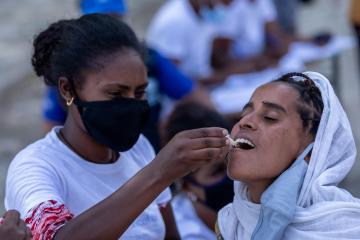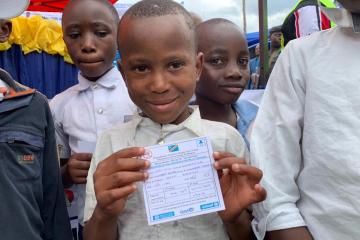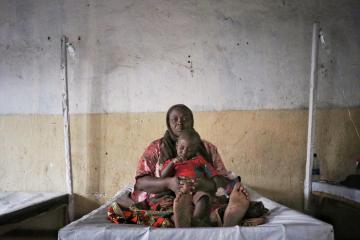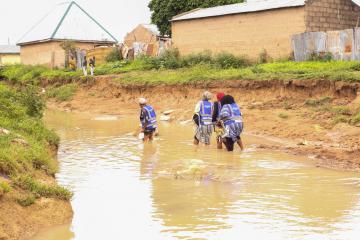Factsheet
Key Facts
- Cholera is an acute diarrhoeal disease that can kill within hours if left untreated.
- Researchers have estimated that each year there are 1.3 to 4.0 million cases of cholera, and 21 000 to 143 000 deaths worldwide due to cholera1.
- Most of those infected will have no or mild symptoms, and can be successfully treated with oral rehydration solution.
- Severe cases will need rapid treatment with intravenous fluids and antibiotics.
- Provision of safe water and sanitation is critical to control the transmission of cholera and other waterborne diseases.
- Oral cholera vaccines are an additional way to control cholera, but should not replace conventional control measures.
- Safe oral cholera vaccines should be used in conjunction with improvements in water and sanitation to control cholera outbreaks and for prevention in areas known to be high risk for cholera.
Cholera is an acute diarrhoeal infection caused by ingestion of food or water contaminated with the bacterium Vibrio cholerae. Cholera remains a global threat to public health and an indicator of inequity and lack of social development. Researchers have estimated that every year, there are roughly 1.3 to 4.0 million cases, and 21 000 to 143 000 deaths worldwide due to cholera (1).
Cholera is an extremely virulent disease that can cause severe acute watery diarrhoea. It takes between 12 hours and 5 days for a person to show symptoms after ingesting contaminated food or water (2). Cholera affects both children and adults and can kill within hours if untreated.
Most people infected with V. cholerae do not develop any symptoms, although the bacteria are present in their faeces for 1-10 days after infection and are shed back into the environment, potentially infecting other people.
Among people who develop symptoms, the majority have mild or moderate symptoms, while a minority develop acute watery diarrhoea with severe dehydration. This can lead to death if left untreated.
During the 19th century, cholera spread across the world from its original reservoir in the Ganges delta in India. Six subsequent pandemics killed millions of people across all continents. The current (seventh) pandemic started in South Asia in 1961, and reached Africa in 1971 and the Americas in 1991. Cholera is now endemic in many countries.
There are many serogroups of V. cholerae, but only two – O1 and O139 – cause outbreaks. V. cholerae O1 has caused all recent outbreaks. V. cholerae O139 – first identified in Bangladesh in 1992 – caused outbreaks in the past, but recently has only been identified in sporadic cases. It has never been identified outside Asia. There is no difference in the illness caused by the two serogroups.
The main reservoirs of V. cholerae are people and aquatic sources that are somewhat salty and warm such as estuaries and some coastal areas. Recent studies indicate that climate change creates a favourable environment for the bacteria that causes cholera (3).
Cholera can be endemic or epidemic. A cholera-endemic area is an area where confirmed cholera cases were detected during 3 out of the last 5 years with evidence of local transmission (meaning the cases are not imported from elsewhere). A cholera outbreak/epidemic is defined by the occurrence of at least 1 confirmed case of cholera with evidence of local transmission in an area where there is not usually cholera.
Cholera transmission is closely linked to inadequate access to clean water and sanitation facilities. Typical at-risk areas include peri-urban slums, where basic infrastructure is not available, as well as camps for internally displaced persons or refugees, where minimum requirements of clean water and sanitation have not been met.
The consequences of a humanitarian crisis – such as disruption of water and sanitation systems, or the displacement of populations to inadequate and overcrowded camps – can increase the risk of cholera transmission, should the bacteria be present or introduced. Uninfected dead bodies have never been reported as the source of epidemics.
The number of cholera cases reported to WHO has continued to be high over the last few years. During 2015,172 454 cases were notified from 42 countries, including 1304 deaths (4). The discrepancy between these figures and the estimated burden of the disease is due to the fact that many cases are not recorded due to limitations in surveillance systems and fear of impact on trade and tourism.
A multifaceted approach is key to prevent and control cholera, and to reduce deaths. A combination of surveillance, water, sanitation and hygiene, social mobilisation, treatment, and oral cholera vaccines are used.
Cholera surveillance should be part of an integrated disease surveillance system that includes feedback at the local level and information-sharing at the global level.
Cholera cases are detected based on clinical suspicion in patients who present with severe acute watery diarrhoea. The suspicion is then confirmed by identifying V. cholerae in stool samples from affected patients. Local capacity to detect (diagnose) and monitor (collect, compile, and analyse data) cholera occurrence is central to an effective surveillance system and to plan control measures.
Countries neighbouring cholera-affected areas are encouraged to strengthen disease surveillance and national preparedness to rapidly detect and respond to outbreaks should cholera spread across borders. Under the International Health Regulations, notification of all cases of cholera is no longer mandatory. However, public health events involving cholera must always be assessed against the criteria provided in the regulations to determine whether there is a need for official notification.
The long-term solution for cholera control (which benefits all diseases spread by the fecal-oral route) lies in economic development and universal access to safe drinking water and adequate sanitation. These measures prevent both epidemic and endemic cholera.
Actions targeting environmental conditions include:
- the development of piped water systems with water treatment facilities (chlorination)
- interventions at the household level (water filtration, chemical or solar disinfection of water, safe water storage)
- the construction of systems for safe sewage disposal, including latrines.
Many of these interventions require substantial long-term investments and continued maintenance, making them difficult to fund and sustain by less developed countries where the interventions are most needed.
Cholera is an easily treatable disease. The majority of people can be treated successfully through prompt administration of oral rehydration solution (ORS). The WHO/UNICEF ORS standard sachet is dissolved in 1 litre (L) of clean water. Adult patients may require up to 6 L of ORS to treat moderate dehydration on the first day.
Severely dehydrated patients are at risk of shock and require the rapid administration of intravenous fluids. A 70 kg adult will require at least 7 L of intravenous fluid, plus ORS during their treatment. These patients are also given appropriate antibiotics to diminish the duration of diarrhoea, reduce the volume of rehydration fluids needed, and shorten the amount and duration of V. cholerae excretion in their stool.
Mass administration of antibiotics is not recommended, as it has no proven effect on the spread of cholera and contributes to increasing antimicrobial resistance.
Rapid access to treatment is essential during a cholera outbreak. Oral rehydration should be available in communities, in addition to larger centres that can provide intravenous fluids and 24 hour care. With early and proper treatment, the case fatality rate should remain below 1%.
Health education campaigns, adapted to local culture and beliefs, should promote the adoption of appropriate hygiene practices such as hand-washing with soap, safe preparation and storage of food and safe disposal of the faeces of children. Funeral practices for individuals who die from cholera must be adapted to prevent infection among attendees. Breastfeeding should also be promoted.
Further, awareness campaigns should be organised during outbreaks, and information should be provided to the community about the potential risks and symptoms of cholera, precautions to take to avoid cholera, when and where to report cases and to seek immediate treatment when symptoms appear. The location of appropriate treatment sites should also be shared.
Currently there are 3 WHO pre-qualified oral cholera vaccines: Dukoral®, Shanchol™, and Euvichol®. All 3 vaccines require 2 doses for full protection (5).
Dukoral® is administered with a buffer solution that, for adults, requires 150 ml of clean water. As access to clean water is often limited in areas with cholera epidemics, Dukoral® is mainly used for travellers. Dukoral® provides approximately 65% protection against cholera for 2 years.
Shanchol™ and Euvichol® are essentially the same vaccine produced by 2 different manufacturers. They do not require a buffer solution for administration, which makes them easier to administer to large numbers of people in emergency contexts. There must be a minimum of 2 weeks delay between each dose of these 2 vaccines. However, 1 dose of vaccine will provide some protection with the second dose given at a later date.
Individuals vaccinated with Shanchol™ or Euvichol® have approximately 65% protection against cholera for up to 5 years following vaccination in endemic areas. The reduced circulation of V. cholerae bacteria in the population due to the reduced number of people with cholera further reduces cholera in the population. This additional protection is called herd protection.
In 2013, WHO established a stockpile of 2 million doses for use in outbreak control and emergencies. The stockpile is managed by the International Coordinating Group (ICG) made up of the International Federation of Red Cross and Red Crescent Societies, Medecins Sans Frontieres, UNICEF, and WHO.
For non-emergency settings, vaccines are available via the Global Task Force on Cholera Control (see WHO response section below). In these contexts, oral cholera vaccines (OCVs) are used as part of a longer-term cholera control plan including reinforcement of other aspects of cholera control. In eligible countries, financial support for vaccines is provided by Gavi, the Vaccine Alliance.
More than 5 million doses of OCVs have been used in mass vaccination campaigns with WHO support. The campaigns have been implemented in areas experiencing an outbreak in areas at heightened vulnerability during humanitarian crises, and among populations living in highly endemic areas, known as “hotspots”.
The use of OCVs has enabled the collection of evidence on and demonstration of the effectiveness and feasibility of implementating OCV campaigns as a public health tool, protecting populations at high risk of cholera.
In 2014 the Global Task Force on Cholera Control (GTFCC), with its Secretariat based at WHO, was revitalised. The GTFCC is a network of more than 50 partners active in cholera control globally, including academic institutions, non-governmental organisations and United National agencies. Through the GTFCC and with support from donors, WHO works to:
- promote the design and implementation of global strategies to contribute to capacity development for cholera prevention and control globally;
- provide a forum for technical exchange, coordination, and cooperation on cholera-related activities to strengthen country capacity to prevent and control cholera;
- support countries for the implementation of effective cholera control strategies and monitoring of progress;
- disseminate technical guidelines and operational manuals;
- support the development of a research agenda with emphasis on evaluating innovative approaches to cholera prevention and control in affected countries; and
- increase the visibility of cholera as an important global public health problem through the dissemination of information about cholera prevention and control, and conducting advocacy and resource mobilization activities to support cholera prevention and control at national, regional, and global levels.
To ensure efficient and effective deployment of necessary materials for the investigation and confirmation of cholera outbreaks, as well as the treatment of cholera patients, WHO has developed a set of cholera kits.
After consultation with implementing partners, WHO revised the cholera kits in 2016 to better meet field needs. In total there are 6 kits:
- 1 for investigation
- 1 with laboratory supplies for confirmation
- 3 for the community, peripheral and central levels
- 1 support kit with logistical materials such as solar lamps, fencing and water bladders and taps.
Each treatment kit provides enough material to treat 100 patients. The revised cholera kits are designed to help prepare for a potential cholera outbreak and to support the first month of the initial response.
Cholera is an acute enteric infection caused by the ingestion of bacterium Vibrio cholerae present in faecally contaminated water or food. Primarily linked to insufficient access to safe water and proper sanitation, its impact can be even more dramatic in areas where basic environmental infrastructures are disrupted or have been destroyed. Countries facing complex emergencies are particularly vulnerable to cholera outbreaks. Massive displacement of IDPs or refugees to overcrowded settings, where the provision of potable water and sanitation is challenging, constitutes also a risk factor. In consequence, it is of paramount importance to be able to rely on accurate surveillance data to monitor the evolution of the outbreak and to put in place adequate intervention measures Coordination of the different sectors involved is essential, and WHO calls for the cooperation of all to limit the effect of cholera on populations.
Cholera is characterized in its most severe form by a sudden onset of acute watery diarrhoea that can lead to death by severe dehydration. The extremely short incubation period - two hours to five days - enhances the potentially explosive pattern of outbreaks, as the number of cases can rise very quickly. About 75% of people infected with cholera do not develop any symptoms. However, the pathogens stay in their faeces for 7 to 14 days and are shed back into the environment, possibly infecting other individuals. Cholera is an extremely virulent disease that affects both children and adults. Unlike other diarrhoeal diseases, it can kill healthy adults within hours. Individuals with lower immunity, such as malnourished children or people living with HIV, are at greater risk of death if infected by cholera.
Key messages
- Cholera is transmitted through contaminated water or food.
- Cholera can rapidly lead to severe dehydration and death if left untreated.
- Prevention and preparedness of cholera require a coordinated multidisciplinary approach.
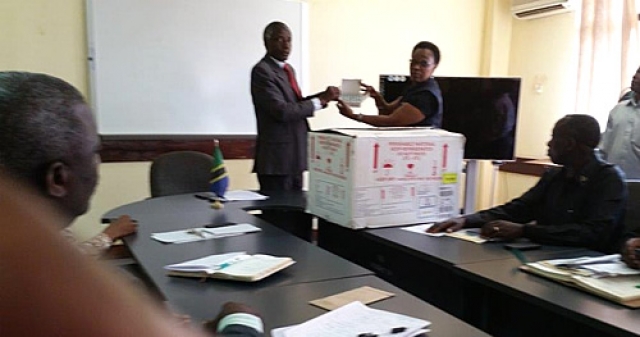
Kigoma, 18 June 2015 – The cholera risk remains high in villages around entry points for asylum seekers in Kigoma region, Western Tanzania. The daily influx of asylum seekers has caused the population in the Nyarugusu camp in Tanzania to swell to over 55 500.
Since the start of the outbreak on 10 May 2015, 4662 suspected/confirmed cholera cases and 34 deaths have been reported. Among these are 129 cases and 3 deaths among Tanzanians, mainly in Kagunga village, Kigoma urban and Karago village.
The increasing numbers in affected local populations is worrisome and has prompted a scale-up of standard cholera prevention and control interventions as well as pre-emptive measures such as the use of oral cholera vaccines (OCV). These vaccines can contribute to preventing outbreaks among populations living in high risk areas, where usually recommended control measures are not sufficient.
On Monday, 15 June 2015, the Kigoma Regional Commissioner convened the Regional Primary Health Care Committee to announce the vaccination campaign in high risk areas in the Kigoma region. The Committee agreed on details of how the campaign will be carried out and which high risk villages would receive the vaccine.
The OCV campaign outside the camp will span four days with 28 vaccination teams targeting a population of 54 110. In addition to OCV, the Regional Commissioner emphasised that the provision of safe water, sanitation and personal hygiene will continue to be the main cholera prevention and control measures.
“To support the campaign, WHO and partners have mobilized 164 500 doses of OCV and they will be provided to all refugees at the Nyarugusu camp, as well as at-risk Tanzanian communities neighbouring the camp, and identified villages such as Kagunga, Karago and Kigoma Ujiji,” says Dr Rufaro Chatora, World Health Organization (WHO) Representative for Tanzania.
Dr Chatora says experience indicates that mass vaccination campaigns cannot be improvised at the last moment – they need careful, advanced planning and preparation, including improving risk assessment, identification of target populations and logistics.
“Carrying out social mobilization, including door-to-door campaigns and health education is a key component to educate populations and inform district and community leaders about the disease. Additional staff from WHO and UNICEF have arrived to support the Regional Health Management Team and facilitate the coordination and preparation of the campaign in order to reach and protect as many people as we can,” Dr Chatora adds.
To further prevent the spread to local populations, District Response teams are conducting targeted household water treatment with water guard in the affected families; strengthening disinfection in the households that have referred cases, intensifying hygiene promotion in the general communities and strengthening case management.
WHO continues to support the Ministry of Health and Social Welfare to strengthen local health facilities along Lake Tanganyika’s shores by stocking them with enough medical supplies to treat new cholera cases and other common ailments. WHO is recruiting public health experts to work with the Regional Medical Team on surveillance and outbreak control. If required, support will be provided to re-deploy Government health workers to provide essential medical care should caseloads increase.
Intensive national and international efforts continue from key stakeholders that include UNHCR, United Nations Children's Fund (UNICEF), United Nations Population Fund (UNFPA), International Rescue Committee (IRC), Red Cross, Médecins Sans Frontières (MSF), Tanzania Water and Environmental Sanitation (TWESA), CARITAS, Plan International, and World Food Programme (WFP).
______________________________________________________
For further information and interview requests, please contact:
WHO Country Office, United Republic of Tanzania
Ms Leticia Rweyemamu; Tel: +255 713 492441; Email: rweyemamul [at] who.int
Dr Neema Kileo; Tel: +255 755 551804; Email: kileon [at] who.int
WHO Regional Office for Africa
Dr Cory Couillard; Tel: + 472 413 9995; Email: couillardc [at] who.int



